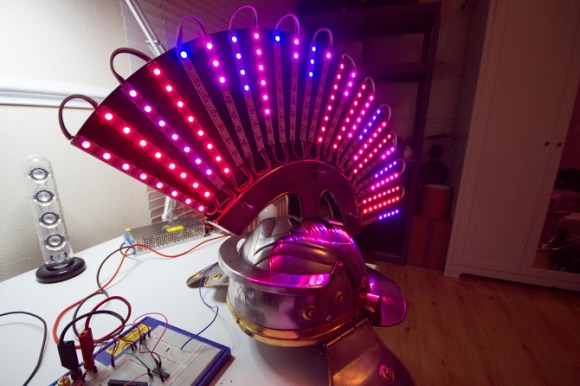
Look, it’s not Steam-Punk because the period is way out of whack. And we’ve never seen ourselves as “that guy” at the party. But it would be pretty hard to develop The Centurion Project and not take the thing to every festive gathering you could possibly attend. This sound-reactive helm compels party-going in a toga-nouveau sort of way.
[Roman] tells us that it started as a movie prop. The first build step was to remove the plume from the top of it. The replacement — seven meters worth of addressable RGB LEDS — looks just enough like an epic mohawk to elicit visions of the punk rock show, with the reactive patterns to make it Daft. The unexpected comes with the FFT generated audio visualizations. They’re grounded on the top side of each of the LED strips. Most would call that upside-down but it ends up being the defining factor in this build. Seriously, watch the demo after the break and just try to make your case that this would have been better the other way around.
As a final note, this project was written using Cinder. It’s an Open Source C++ library that we don’t remember hearing about before.















The running man reenactment here I come.
Dynamo, eat your heart out !
But nothing looks as silly as an Apple penis speaker.
That’s DY-NO-MITE !
Super nifty lighted hat…
But, no, it does not look just enough like an epic mohawk… https://en.wikipedia.org/wiki/Mohawk_people#Traditional_Mohawk_dress
Damn Hollywood. Calling a Pawnee hairstyle a “Mohawk” is a meme that’s persisted since the 1939 movie “Drums along the Mohawk”.
And stop calling tartan patterns “plaid”. A plaid is a cloth made with a tartan pattern wrapped around the waist and cast over the shoulder and fastened at the front. The literal Gaelic meaning is “blanket”. Plaid blanket is as redundant as ATM Machine or PIN Number.
Still a nifty lighted hat, a Jaegermonster would kill for it. :)
Language is a living thing and meaning is dictated by the users.
Stop being such a pedantic bundle of sticks.
“bundle of sticks” i see what you did there lol
Table pad is instigation? It’s rubberized Elwood harmonius parfait. Under Eppelsteins curvacious tape dispensing nipple. Has are upstanding? Glorious!
I’m so going to build a plaid mohawk and wear it when entering my pin number at an ATM machine.
Tartan just means a woven fabric, and does not imply a certain pattern. Please stop using the word that way.
Get off your high horse. “Plaid” means “Party” in Welsh…perfectly appropriate for this particular application.
Does it come with an illudium Q-36 explosive space modulator?
http://youtu.be/QuUJfYcn3V4
Centurio autem, et qui non cognoverunt te homosexuales. (God I love google translate!)
are you going to chase arnold Schwarzenegger arround in an electric car?
Jamiroquai anyone?!
Nope – I still think it would be better “right-side up”
I got all excited for a second, thinking that this Cinder library might contain some useful functionality for embedded applications.
Shame; I see that it’s what’s doing the audio processing on OSX, before passing data to an Arduino DUE, which then drives the LEDs (the helmet must be tethered to a host computer at the moment).
I’m a little dubious of the claim that it requires a Cortex M3 to drive that many WS2812’s, especially with no processor overhead required for the audio analysis, but I can appreciate that he might be planning to move the analysis to the Due at a later date, so fair play.
Certainly beats my old festival hat; I have been inspired to start work on a Mk2 for this season!